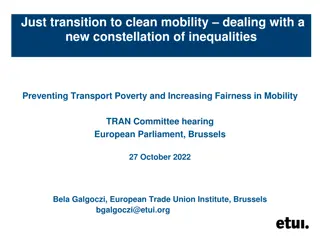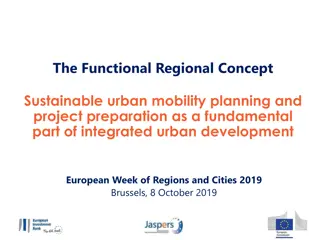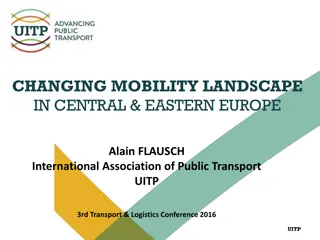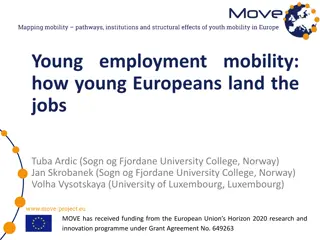Understanding Social Mobility: Types and Implications
Social mobility involves the shift in an individual's social status, with various types such as horizontal, vertical, and upward mobility. Pitirim Sorokin introduced this concept, highlighting how societies differ in mobility opportunities. While upward mobility is often seen positively, it can come with challenges as individuals adjust to new roles and environments.
Download Presentation

Please find below an Image/Link to download the presentation.
The content on the website is provided AS IS for your information and personal use only. It may not be sold, licensed, or shared on other websites without obtaining consent from the author. Download presentation by click this link. If you encounter any issues during the download, it is possible that the publisher has removed the file from their server.
E N D
Presentation Transcript
SUSMITA ROY 1 3 .0 8 .2 1 SOCIOLOGY
What is Social Mobility? ? Social mobility refers to the shift in an individual s social status from one status to another. The shift can either be higher, lower, inter-generational, or intra-generational, and it cannot necessarily be determined if the change is for good or bad. Origin of the Social Mobility Concept Russian-born American sociologist and political activist Pitirim Sorokin first introduced the concept of social mobility in his book Social and Cultural Mobility. He states that there is no society that is completely open (such as the class system) and no society that is completely closed (like the caste system in India). According to Sorokin, no two societies are the same in terms of movement allowed and discouraged, and that the speed of social mobility can change from one time period to the next. It depends on how developed the society is. Such a societal shift can happen over time as individuals move from one position to another due to various social interactions. Mobility, more or less, provides people with benefits as they are motivated by different factors in society and work to reach new roles that offer them a better standard of living and greater rewards. People compete and cooperate with others in society to move up the social mobility ladder.
Types of Social Mobility Social mobility can take different forms, and people can experience different types of mobility in different stages of their lives. The types of mobilities are independent of one another and can often overlap. They are only distinguished for the purpose of analysis. 1 1. Horizontal mobility This occurs when a person changes their occupation but their overall social standing remains unchanged. For example, if a doctor goes from practicing medicine to teaching in a medical school, the occupation s changed but their prestige and social standing likely remain the same. Sorokin describes horizontal mobility as a change in religious, territorial, political, or other horizontal shifts with no change in the vertical position.
2 2. Vertical mobility This refers to a change in the occupational, political, or religious status of a person that causes a change in their societal position. An individual moves from one social stratum to another. Vertical mobility can be ascending or descending. Ascending involves an individual moving from a group in a lower stratum to a higher one or the creation of a similar group with a higher societal position, instead of side by side with its existing group. Descending mobility occurs, for example, when a businessman incurs losses in his business and is forced to declare bankruptcy, resulting in a move to a lower stratum of society. 3 3. Upward mobility This is when a person moves from a lower position in society to a higher one. It can also include people occupying higher positions in the same societal group. However, upward mobility, while seen as a good thing, can also come at a cost for individuals. When a person moves upward, they often need to leave behind familiar surroundings such as family and places. They may also need to change their way of thinking and behavior. The individual will need to adapt to the new environment as a result of their upward movement and adopt different behaviors in the new society.
4. Downward mobility Downward mobility takes place when a person moves from a higher position in society to a lower one. It can occur when someone is caught performing a wrongful act that can result in the loss of the position they currently hold. Downward mobility can be extremely stressful for people who face a rapid decline in their social status. They may find it hard to adapt to the new environment, as it is not similar to the standard of living they are used to. Downward mobility is an example of the extent to which a society values equal opportunity and structure. 5. Inter-generational mobility Inter-generational mobility happens when the social position changes from one generation to another. The change can be upward or downward. For example, a father worked in a factory while his son received an education that allowed him to become a lawyer or a doctor. Such societal change also causes the generation to adopt a new way of living and thinking. Inter-generational mobility is affected by the differences in the parents and their offspring s upbringing, changes in population, and changes in occupation.
6 6. Intra-generational mobility The intra-generational change in societal position occurs during the lifespan of a single generation. It can also refer to a change in position between siblings. One way is when a person climbs up the corporate ladder in their career. For example, an individual starts their career as a clerk and through their life moves on to a senior position such as a director. One sibling may also achieve a higher position in society than their brother or sister.
Horizontal and Vertical Mobility in Society The movement can obviously occur in any of three directions from lower to higher, from higher to lower, or between two positions at the same level. The first two types of movement are known as vertical mobility and the third one as horizontal mobility. In other words, when a person changes his status by moving from one position to another, the movement is called vertical mobility. Vertical mobility may be either upward or downward, depending on whether one enhances one s social status or loses it. On the other hand, when a person moves from one position to another and does not change his status in any way, the movement is known as horizontal mobility. It is to be particularly noted that suitability for a particular position (or task) depends entirely on native talent and that ascriptive statuses, such as lineage, ethnic membership, father s position, etc., would not in any way impede the free flow of persons into positions most suitable for them. By contrast, in a totally closed society, in which possibilities of upward vertical mobility are absent, the individuals are assigned positions at birth. Once such positions are assigned, they cannot advance and improve their social status in any way.
Vertical mobility is particularly significant in social life. In the first place, vertical mobility is consistent with democratic ideals of society. Equal opportunity for all is an important democratic principle, and this is exactly what is implied in vertical mobility. Secondly, absence of vertical mobility impedes the free flow of talents into positions in which such talents are needed most. In cases such as these, the society loses. Moreover, absence of mobility creates conditions in which potentialities of individuals are not Realized in full and put into use. It is not obviously possible for anyone to realise his latent talents in a vacuum. Such talents get atrophied in the absence of opportunities for using these talents. Causes of Vertical Social Mobility: We know that vertical mobility is present, in some form or other, in all societies. From that point of view, it is an inherent trait of all stratified societies. Why is it so ? Obviously, there are some inherent causes. Some of these causes are noted below:
In societies where some upper positions are filled for a definite period, it follows that on the expiry of the term, the previous incumbents have to be replaced. Hence the inevitability of new persons being elevated to high positions. If the incumbents are chosen from all the strata of society, there is a possibility of the vertical current circulating from the bottom to the top. There are certain criteria for evaluating people in different strata. Those who belong to the lower strata will obviously try to acquire or emulate the ways of life, manners and life-styles of those who belong to the upper strata. In course of time, the people belonging to the lower strata would be able to qualify for membership of the upper strata. Reference may be made, in this connection, to sanskritization . In many societies vertical mobility is caused by an insufficient self-perpetuation of the upper strata. Through a low birth rate within the upper layers, a social vacuum may be created which can only be filled by persons recruited from the lower layers. A general cause of vertical mobility is the unfitness of many individuals to perform the proper functions of their social stratum.
This may be caused by: a) the dissimilarity of parents and children in terms of capacity and (b) the profound change which many persons undergo in the course of their lives. It is obvious that a fairly high degree of correspondence between the social positions of the members and their ability to perform the proper functions of their strata is a prerequisite for the continued existence of the group. When the discrepancy becomes too great, the people who fail to come up to the standard have to yield place to others. For instance, a man of ability dynamic, intelligent and resourceful may have built up a business empire in his life time.
If his son does not possess the qualities to perform his tasks enjoined by his position, be cannot obviously stay there. Nature abhors vacuum. As such, he will be replaced by more capable persons from below. Sometimes persons undergo a profound change in the course of their lifetime owing to physical or mental sickness, accidents, and such other causes. They may lose their ability, because of these changes, to perform properly their functions. Hence, the need arises for replacing such persons with different ones. v) Another cause of vertical mobility is an incessant change in the environment, particularly in the socio-cultural environment of groups and their members. Changes in the socio- cultural environment create, almost without cessation, favourable conditions for some members and unfavorable conditions for others, leading respectively to promotion and demotion.
THANK YOU THANK YOU






















